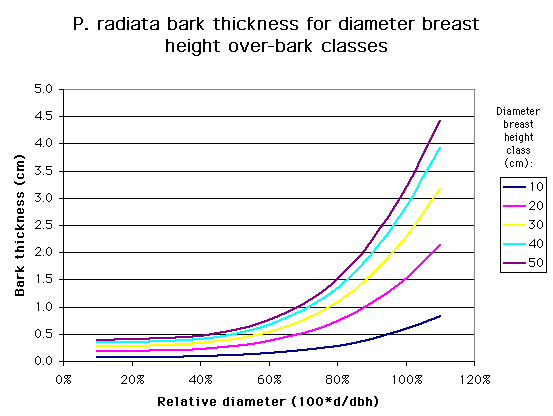
Forest Measurement and Modelling.
 |
Bark Forest Measurement and Modelling. |
     |
|
Bark is the outer sheath of the tree. Some trees annually shed bark, while others have persistent bark. The inner bark transports photosynthates from the crown, while the outer bark has a major protective role. The bark protects the bole from insects and damage from physical abrasion. It is also important for fire resistance. The underbark measurement of diameter or sectional area at breast height is more closely related to wood volume than the equivalent measurement over bark. Thus, the determination of bark is important for estimating wood volume that could be extracted from trees or logs. Because bark is a suitable growing medium for horticultural purposes, estimates of the amount of bark available for harvesting is also of commercial interest. |
|
| What to measure |
|
| Measurement techniques |
On felled trees and logs, bark thickness can be directly measured at the cut ends. A small chip of bark can also be cut and the thickness measured. However, cutting the chip with an axe may compress the bark and provide biased estimates. Where a ring of bark can be removed, the diameter over-bark and diameter under-bark can be measured. Bark thickness is one-half of the difference between over-bark and under-bark diameter. On standing trees, bark thickness is measured indirectly. A probe is pushed through the bark to meet the wood interface and the length of penetration measured. Because bark varies around the bole, an average of four measurements (evenly spaced or where the calliper arms contact the bole) is normally required. Bark sectional area is normally calculated as the difference between over-bark and under-bark sectional area. Similarly, bark volume is the difference between over-bark and under-bark volume, where volume is by the standard sectional or other technique. Thus diameter over-bark and bark thickness, at a number of heights up the bole, needs to be determined. Bark surface area (a) may be calculated by assuming that the bole is a quadratic paraboloid of basal diameter (D - under-bark) and tree height (h): 
|
| Modelling |
Measuring bark thickness is difficult. Direct methods are destructive, and the use of a Bark Probe or Gauge requires experience and "feel". Bark thickness is also needed at locations up along the bole (e.g. for volume estimation), which adds the complication of safely climbing the tree and pushing a gauge in while metres above the ground. Thus, ways of predicting bark thickness from easily measured parameters are important. Bark thickness decreases from the ground to the tree tip. This decrease may be related to the rate of taper of the bole, but there are often irregularities and anomalies. Bark thickness varies with species; genetic constitution; site; tree age, health and size; rate of growth; bark persistence; and position along the bole. Many hardwood trees maintain a reasonably constant ratio of diameter under-bark to diameter over-bark along the tree bole. Thus diameter under-bark at any point along the tree may be calculated by multiplying over-bark diameter by the ratio of under- to over-bark diameter at breast height. For many other tree species, particularly conifers, the under- to over-bark diameter ratio of increases with increasing height along the bole. That is, the relative bark thickness decreases. A few rare species have a decreasing ratio of under- to over-bark diameter. Where the ratio of under- to over-bark diameter is not constant, equations may be developed to predict bark thickness from measurements at ground level. For example, Johnson and Wood (1987) estimated bark thickness (b) for Pinus radiata in ACT from measurements of diameter over-bark and bark thickness at breast height (dbh and bbh respectively) and the diameter over-bark at any nominated point:  This equation appeared to be reliable in all plantation forests of the ACT and is independent of site and age. Equations may also be fitted to predict bark thickness or diameter under-bark at breast height. For example, a quadratic polynomial equation fitted to P. radiata data from the ACT explained over 90% of the variation in bark thickness at breast height (bbh): bbh = -0.558 + 0.127*dbh - 0.00101*dbh^2  Combining the above two equations allows bark thickness to be predicted for any height up the bole when only dbh and over-bark diameter (or relative over-bark diameter) is known.
Combining the above two equations allows bark thickness to be predicted for any height up the bole when only dbh and over-bark diameter (or relative over-bark diameter) is known. |

|
[bark.htm] Revision: 6/1999 |